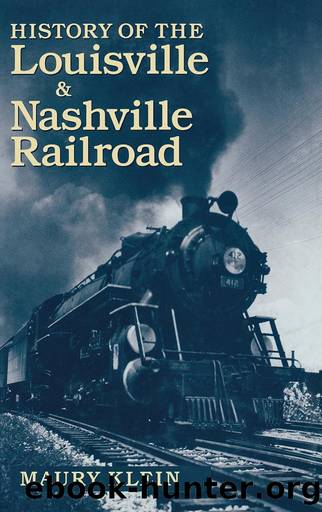History of the Louisville & Nashville Railroad by Maury Klein

Author:Maury Klein [Klein, Maury]
Language: eng
Format: epub
Tags: Transportation, Railroads, history, Business & Economics, Corporate & Business History, United States, State & Local, South (AL; AR; FL; GA; KY; LA; MS; NC; SC; TN; VA; WV)
ISBN: 9780813146768
Google: y2Y1EAAAQBAJ
Publisher: University Press of Kentucky
Published: 2014-04-23T00:11:12.038523+00:00
The mineral lines: L & N system in Alabama, 1890.
Scarcely had the new company been formed when Smith moved to fashion it into a complete and efficient line. He changed the Anniston & Atlantic to standard gauge, replaced the 30-pound rail with 50-pound rail, and altered the road at crucial points. In January, 1891, he completed a 34-mile extension of the southern portion of the road from Sylacouga to a connection with the South & North Alabama at Calera, thirty-four miles south of Birmingham. Completion of the lopsided circle around Birmingham had to await further development of the district northeast of the city. There remained a 26-mile gap between Attalla and Champion, Alabama, the northern terminus of the Birmingham Mineralâs Huntsville Branch No. 2. In sporadic fashion the L & N absorbed small roads and built extensions to piece together the final link by May, 1905. At Attalla the Alabama Mineral connected with the Tennessee & Coosa Railroad, which was acquired by the Nashville, Chattanooga & St. Louis and extended northward until it reached the parent companyâs main stem. The resulting line shortened the distance between Anniston and Nashville, created a new line to Chattanooga, and penetrated the mining region around the Sequatchie Valley.
The Alabama Mineral proved a valuable supplement to its companion road. The brown hematite ores were carried to the Birmingham furnaces to be mixed with the red hematite ores found in Red Mountain. The resulting blend yielded a better quality and larger quantity of iron than either single ore. Moreover, the process produced a maximum use of rolling stock. Cars transporting coal and coke to the facilities at Anniston, Talladega, Shelby, Gadsden, and Attalla could be unloaded and promptly refilled with brown ore.
Here, as elsewhere, Smith lost no chance to promote new enterprises promising traffic for the L & N. While progress on the Attalla-Champion link of the Alabama Mineral languished some operators were already staking out the undeveloped ground in western Etowah and Blount counties. In the spring of 1900 William T. Underwood secured control of large coal tracts in that region. Eager to open mines but miles from available transportation, he went to the nearest road to his property, the Alabama Great Southern (owned by the Southern Railway) and asked for help. The Southern offered neither trackage nor assistance. Going next to Smith, Underwood got a ready response. âIf you have the quality and quantity of coal you think you have,â Smith said flatly, âI will build you a road.â4
The problem, Underwood responded, was that he could raise no more than a third of the capital needed to open and operate the mines. Smith said he would have to think about that, but he ordered Underwood to haul some thirty wagons of his coal twelve miles to a rail junction. Smith then sent experts to test the coal and verify Underwoodâs claims about its quality. Satisfied that Underwood was correct, he arranged for a Louisville bank to give the Alabama company a large loan. In May, 1900, Smith started construction on a 12-mile extension; by October coal was moving on it.
Download
This site does not store any files on its server. We only index and link to content provided by other sites. Please contact the content providers to delete copyright contents if any and email us, we'll remove relevant links or contents immediately.
Harry Potter and the Goblet Of Fire by J.K. Rowling(3138)
Never by Ken Follett(2952)
Shadow of Night by Deborah Harkness(2777)
Ogilvy on Advertising by David Ogilvy(2723)
Zero to IPO: Over $1 Trillion of Actionable Advice from the World's Most Successful Entrepreneurs by Frederic Kerrest(2529)
Machine Learning at Scale with H2O by Gregory Keys | David Whiting(2363)
The Man Who Died Twice by Richard Osman(2340)
Book of Life by Deborah Harkness(2304)
How Proust Can Change Your Life by Alain De Botton(2284)
My Brilliant Friend by Elena Ferrante(2261)
0041152001443424520 .pdf by Unknown(2247)
The Tipping Point by Malcolm Gladwell(2222)
How to Pay Zero Taxes, 2018 by Jeff A. Schnepper(2126)
Will by Will Smith(2114)
Hooked: A Dark, Contemporary Romance (Never After Series) by Emily McIntire(2033)
Purple Hibiscus by Chimamanda Ngozi Adichie(2018)
Borders by unknow(1805)
Rationality by Steven Pinker(1796)
Daughter of Smoke and Bone by Laini Taylor(1766)
